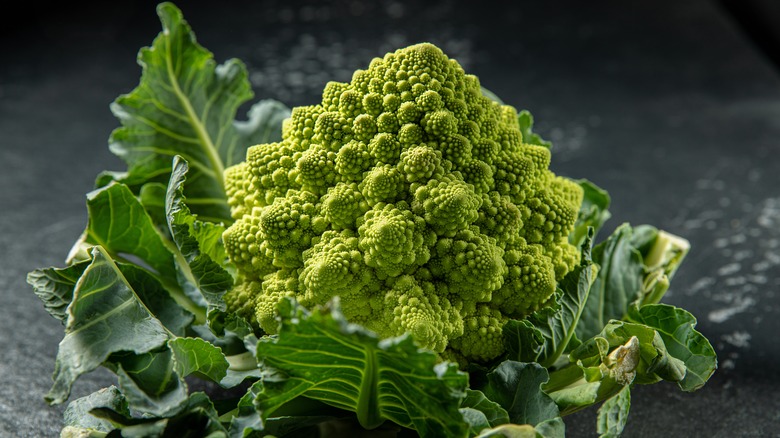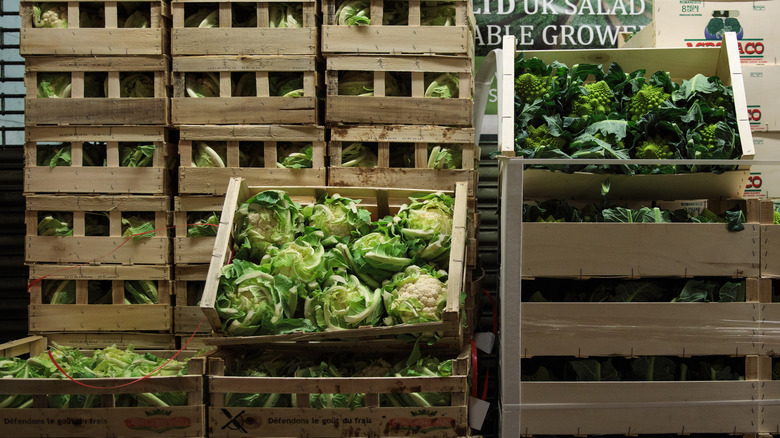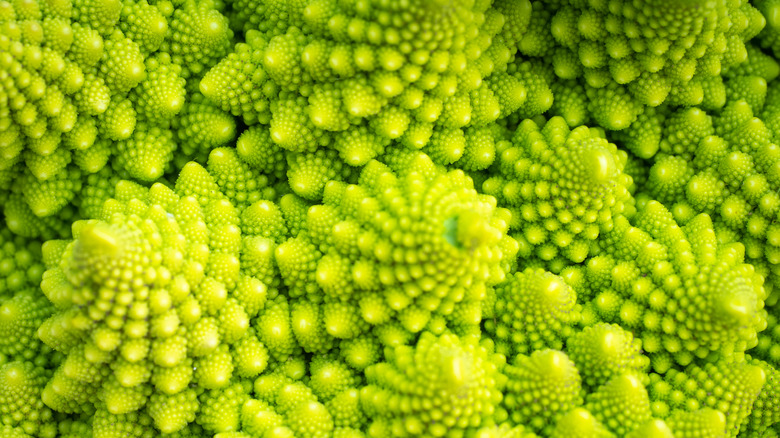Broccoli Vs. Romanesco: What's The Difference?
If you've ever encountered a vegetable in your produce section that looked like it was of alien origins, it was probably a head of romanesco. According to Parade, romanesco is a type of cruciferous vegetable which is a relative to both broccoli and cauliflower. All three grow in similar, vaguely rounded bulbs, but romanesco's florets take on a unique pattern that is all their own. Instead of clustering into smaller, round bulbs, romanesco's florets come together into a spiral shape.
For all the math nerds out there, Garden Betty adds that it even forms something known as a Fibonacci fractal in each individual spiral. Italian farmers in the 16th century likely bred romanesco to develop its signature spiral appearance, per Parade. While beautiful, those spirals can make romanesco seem intimidating to any unfamiliar chefs when compared to broccoli. There are plenty of similarities between these two veggies, though, that makes them great companions.
Nutritional differences
Both broccoli and romanesco are a part of the cruciferous family. According to The Academy of Nutrition and Dietetics, cruciferous is a family of vegetables that includes kale, arugula, brussels sprouts, broccoli, and cauliflower. This vegetable family also has a great reputation for its nutrition, and of course, romanesco is no different.
According to The Land Connection, the nutritional profiles of broccoli and romanesco are fairly similar. Both are excellent sources of vitamins C and K, as well as dietary fiber. Broccoli is also a well-known source of protein. One cup of broccoli contains approximately 2.5 grams of protein, and romanesco contains more than 3.5 grams per cup (via Health Benefits Times). That means if you're using broccoli for its protein-dense benefits, then romanesco is a great stand-in to change things up. Both are also excellent sources of iron, antioxidants, and carotenoids. This means that both of these cruciferous vegetables have the ability to help eyesight, heart health, and prevent the formation of cancerous tumors.
How to cook with romanesco
Because romanesco is a vegetable that falls somewhere between broccoli and cauliflower, it tends to have a similar, if somewhat nuttier, flavor to that of its cousins (per Parade). This flavor can be easily enhanced or elevated as well through a simple roast in the oven.
Because it's so similar, romanesco can be used as a substitute for any recipe that usually calls for broccoli or cauliflower. It can be used to add variety and flavor to an easy broccoli pesto recipe, or a big pot of broccoli cheddar soup. Romanesco's unique visual appeal also makes it really well suited to being served raw as crudité or roasted with citrus, like broccoli.
Regardless of how you prepare it, proper cooking is vital. Romanesco can go from firm and chewy to becoming a mushy mess if it spends too much time cooking. Per Best Health, a fresh head of romanesco will still have its leaves attached and have a distinct heaviness to it, along with its bright green color. It will likely be tucked in with the cauliflower or broccoli, and should be stored in a cool environment like a refrigerator.


